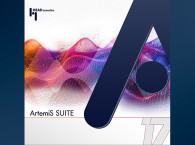
When we see those virtual reality demonstrations at trade shows, we can't help but laugh of the ridiculous complex contraptions just in order to manipulate computer generated environments that are not even effective for gaming. But obviously there are serious application fields in 3D data visualization that are quickly evolving to Augmented Reality, enabling unique interactions, including for measuring physical phenomena such as sound.
The Frankfurt-based startup HoloMetrix GmbH has developed a software platform for acoustic measurements based on Augmented Reality, which projects the virtual measurement grid in three dimensions in the actual measurement environment. HoloMetrix was just recently awarded for this implementation with the 2022 golden German Innovation Award by the German Design Council in a ceremony in Berlin. The award honors companies that impress with new, forward-looking technologies, processes, or services.

While these demonstrations tend to be shown with people using VR goggles on the head - which some marketing departments still associate with "the future" when in reality everything can be performed directly on a touchscreen, fixed or mobile, depending on the application. The combination of an AR visualization layer over real images, with a measurement platform that is running the measurements and calculations, enables a practical process that is not fatiguing and becomes much more intuitive (no goggles, VR gloves and pointers required!).

As HEAD acoustics explains, with the ArtemiS SUITE Sound Intensity Module ASM 30, user can measure sound intensities to determine sound power according to ISO 9614 or create sound intensity maps for quick source localization. The software's assistance functions guides even inexperienced users safely through the process and, if there is a requirement for a measurement grid surrounding the test object, the HoloMetrix generates that layer over the image on the screen, without the need for actual physical setups. All at much lower cost, and much less time-consuming and complicated - great for troubleshooting situations of sound intensity maps for fast source localization, as an example.
The HoloMetrix solution projects the virtual measurement grid onto the AR screen and overlays the real test object and the measurement probe, whose orientation is based on the measurement grid. In addition, it overlays the sound power of the already measured partial surfaces in color, making acoustic measurements intuitive and time-efficient. The standard-compliant measurement positions are automatically visualized.
Thanks to the solution's modular design, HEAD acoustics sees the possibility for further applications beyond sound power, in direct integration with its SQuadriga III and SQobold interfaces and acquisition hardware.

Structural Dynamics Analysis
HEAD acoustics also announced a cooperation with Belgian company Qsources, an established developer and supplier of air- and structure-borne sound sources, to allow structural dynamics analysis with a highly specialized miniature shaker. This integration allows effortless vibration excitations in modal and transfer path analysis, with data acquisition, and analysis using HEAD acoustics software.
"We continuously develop our hardware and software to provide our customers with advanced holistic solutions. Thus, expanding our portfolio with a Qsources shaker is a natural step. The Qlws lightweight shaker ensures the efficient and accurate acquisition of transfer functions and supports both modal and transfer path analysis. This more profound understanding of vibration characteristics is the basis for optimizing the sound quality of our customers' products," says Dr.-Ing. Aulis Telle, Managing Director Sound, Vibration and Perception at HEAD acoustics.
With its small dimensions of about 25mm, the Qlws shaker covers a wide frequency range from 250 to 13,000Hz, enabling dynamic excitation when conventional vibration exciters cannot be structurally integrated, or impulse hammers cannot be used. As it is mounted directly on the test structure, the shaker requires no additional external support and does not need to be aligned. The internal, patented decoupling of the Qlws shaker results in a low mass and impedance loading of the test object.
www.qsources.be
www.holo-metrix.com
www.head-acoustics.com







